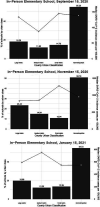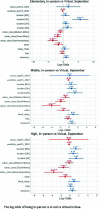Urban Classification, Not COVID-19 Community Rates, Was Associated With Modes of Learning in US K-12 Schools?
- PMID: 34737176
- PMCID: PMC9647778
- DOI: 10.1542/peds.2021-054268M
Urban Classification, Not COVID-19 Community Rates, Was Associated With Modes of Learning in US K-12 Schools?
Abstract
Objectives: To identify factors associated with the decision to provide in-person, hybrid, and remote learning in kindergarten through 12th grade school districts during the 2020-2021 school year.
Methods: We performed a retrospective study evaluating school district mode of learning and community coronavirus 2019 (COVID-19) incidence and percentage positivity rates at 3 time points during the pandemic: (1) September 15, 2020 (the beginning of the school year, before Centers for Disease Control and Prevention guidance); (2) November 15, 2020 (midsemester after the release of Centers for Disease Control and Prevention guidance and an increase of COVID-19 cases); and (3) January 15, 2021 (start of the second semester and peak COVID-19 rates). Five states were included in the analysis: Michigan, Missouri, North Carolina, Ohio, and Wisconsin. The primary outcome was mode of learning in elementary, middle, and high schools during 3 time points. The measures included community COVID-19 incidence and percentage positivity rates, school and student demographics, and county size classification of school location.
Results: No relationship between mode of learning and community COVID-19 rates was observed. County urban classification of school location was associated with mode of learning with school districts in nonmetropolitan and small metropolitan counties more likely to be in-person.
Conclusions: Community COVID-19 rates did not appear to influence the decision of when to provide in-person learning. Further understanding of factors driving the decisions to bring children back into the classroom are needed. Standardizing policies on how schools apply national guidance to local decision-making may decrease disparities in emergent crises.
Copyright © 2022 by the American Academy of Pediatrics.
Conflict of interest statement
Figures


References
-
- United States Centers for Disease Control and Prevention . CDC releases indicators for dynamic school decision-making. Available at: https://www.cdc.gov/media/releases/2020/s0915-dynamic-school-decision-ma.... Accessed August 13, 2021
-
- Verlenden JV, Pampati S, Rasberry CN, et al. Association of children’s mode of school instruction with child and parent experiences and well-being during the COVID-19 pandemic - COVID experiences survey, United States, October 8-November 13, 2020. MMWR Morb Mortal Wkly Rep. 2021;70(11):369–376 - PMC - PubMed
Publication types
MeSH terms
Grants and funding
LinkOut - more resources
Full Text Sources
Medical

